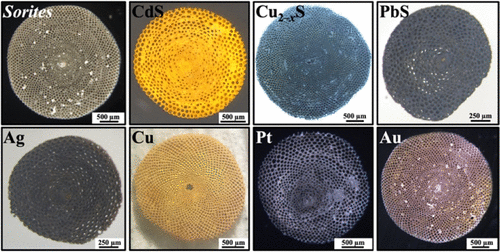当前位置:
X-MOL 学术
›
ACS Appl. Mater. Interfaces
›
论文详情
Our official English website, www.x-mol.net, welcomes your
feedback! (Note: you will need to create a separate account there.)
Calcareous Foraminiferal Shells as a Template for the Formation of Hierarchal Structures of Inorganic Nanomaterials
ACS Applied Materials & Interfaces ( IF 8.3 ) Pub Date : 2019-01-29 00:00:00 , DOI: 10.1021/acsami.8b22138 Mahmud Diab , Karam Shreteh , Michael Volokh , Sigal Abramovich , Uri Abdu , Taleb Mokari
ACS Applied Materials & Interfaces ( IF 8.3 ) Pub Date : 2019-01-29 00:00:00 , DOI: 10.1021/acsami.8b22138 Mahmud Diab , Karam Shreteh , Michael Volokh , Sigal Abramovich , Uri Abdu , Taleb Mokari

|
A microorganism template approach has been explored for the fabrication of various well-defined three-dimensional (3D) structures. However, most of these templates suffer from small size (few μm), difficulty to remove the template, or low surface area, which affect their potential use in different applications or makes industrial scale-up difficult. Conversely, foraminifer’s microorganisms are large (up to 200 mm), consist of CaCO3 (easy to dissolve in mild acid), and have a relatively high surface area (≈5 m2 g–1). Herein, we demonstrate the formation of hierarchical structures of inorganic materials using calcareous foraminiferal shells such as Sorites, Globigerinellasiphonifera, Lox-ostominaamygdaleformis, Calcarinabaculatus or hispida, and Peneroplisplanatus. Several techniques, such as thermal decomposition of single-source precursors of metal oxides or sulfides, reduction of metal salts directly on the surfaces, and redox reactions, were used for coating of different shell materials and several hybrid compositions, which possess nanofeatures. Finally, we examined the role of the prepared 3D structures on the reduction of 4-nitrophenol (4-NP), ethanol electrooxidation, and water purification. A remarkable performance was achieved in each application. The hierarchical structure leads to the reduction of 4-NP within several minutes, a 27 mA cm–2 current density peak was obtained for ethanol electrooxidation, and more than 95% of the organic dye contaminants were successfully removed. These results show that using foraminiferal shells offers a new way for designing complex hierarchical structures with unique properties.
中文翻译:

钙质有孔虫壳作为无机纳米材料的分层结构形成的模板
已经探索了一种微生物模板方法来制造各种明确定义的三维(3D)结构。然而,这些模板中的大多数都具有尺寸小(几微米),难以去除模板或表面积低的问题,这影响了它们在不同应用中的潜在用途或难以进行工业放大。相反,有孔虫的微生物很大(可达200毫米),由CaCO 3组成(易于溶于弱酸),并且具有相对较高的表面积(≈5m 2 g –1)。在此,我们证明了使用石灰质有孔虫外壳,例如无机材料的分层结构的形成复合三段论,Globigerinella siphonifera,LOX-ostomina amygdaleformis,Calcarina baculatus或刚毛,并Peneroplis planatus。几种技术,例如金属氧化物或硫化物的单源前体的热分解,金属盐在表面上的直接还原以及氧化还原反应,被用于涂覆不同的壳材料和几种具有纳米特征的杂化组合物。最后,我们检查了制备的3D结构在还原4-硝基苯酚(4-NP),乙醇电氧化和水净化方面的作用。在每种应用中均实现了卓越的性能。分层结构导致几分钟内4-NP的减少,即27 mA cm –2获得了乙醇电氧化的最大电流密度峰,成功去除了95%以上的有机染料污染物。这些结果表明,使用有孔虫壳为设计具有独特属性的复杂层次结构提供了一种新方法。
更新日期:2019-01-29
中文翻译:

钙质有孔虫壳作为无机纳米材料的分层结构形成的模板
已经探索了一种微生物模板方法来制造各种明确定义的三维(3D)结构。然而,这些模板中的大多数都具有尺寸小(几微米),难以去除模板或表面积低的问题,这影响了它们在不同应用中的潜在用途或难以进行工业放大。相反,有孔虫的微生物很大(可达200毫米),由CaCO 3组成(易于溶于弱酸),并且具有相对较高的表面积(≈5m 2 g –1)。在此,我们证明了使用石灰质有孔虫外壳,例如无机材料的分层结构的形成复合三段论,Globigerinella siphonifera,LOX-ostomina amygdaleformis,Calcarina baculatus或刚毛,并Peneroplis planatus。几种技术,例如金属氧化物或硫化物的单源前体的热分解,金属盐在表面上的直接还原以及氧化还原反应,被用于涂覆不同的壳材料和几种具有纳米特征的杂化组合物。最后,我们检查了制备的3D结构在还原4-硝基苯酚(4-NP),乙醇电氧化和水净化方面的作用。在每种应用中均实现了卓越的性能。分层结构导致几分钟内4-NP的减少,即27 mA cm –2获得了乙醇电氧化的最大电流密度峰,成功去除了95%以上的有机染料污染物。这些结果表明,使用有孔虫壳为设计具有独特属性的复杂层次结构提供了一种新方法。

















































 京公网安备 11010802027423号
京公网安备 11010802027423号